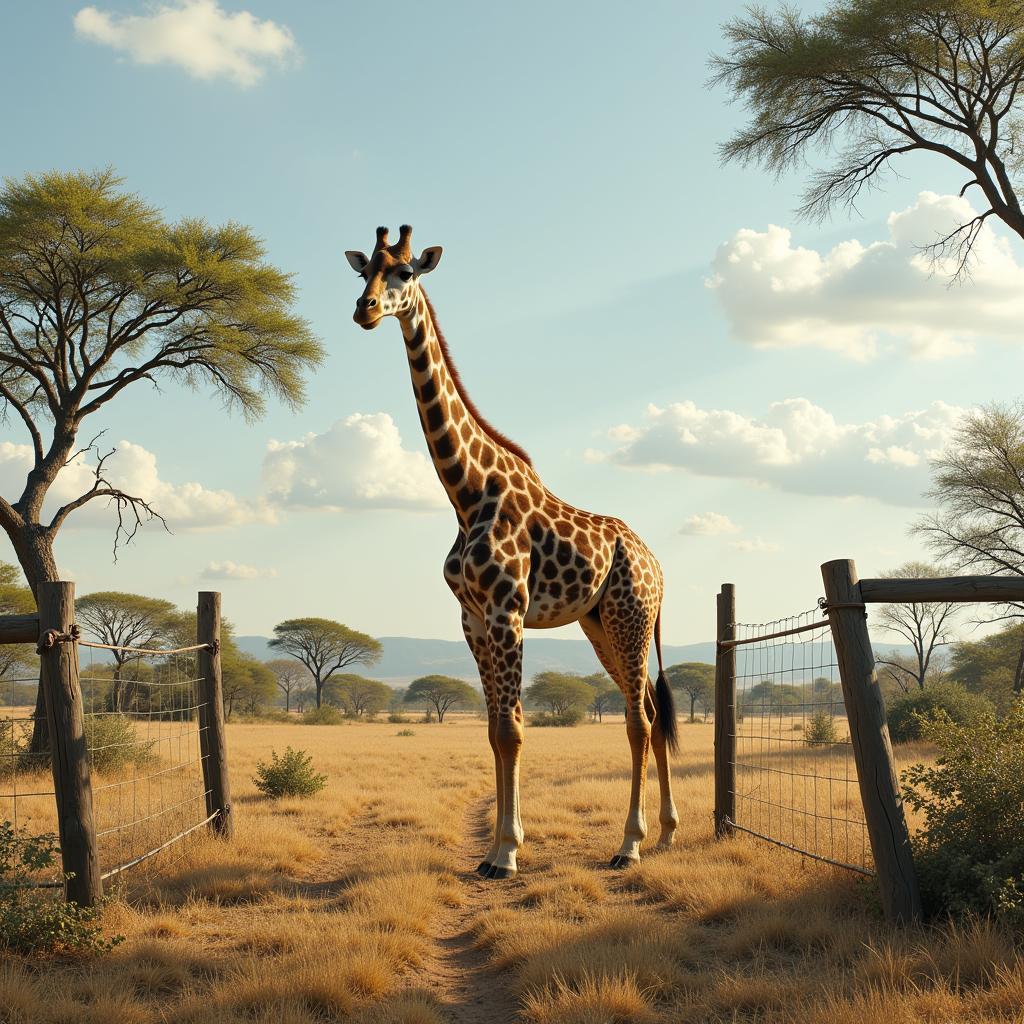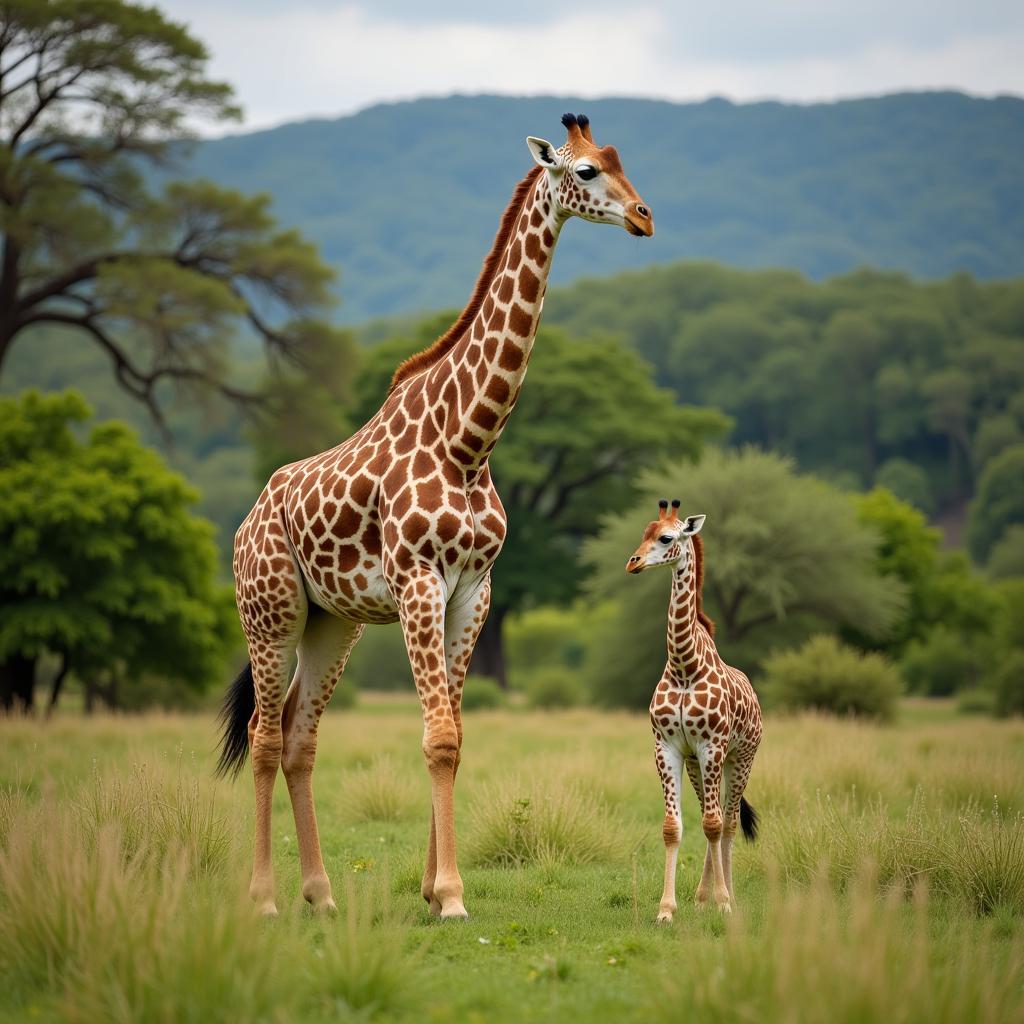Are African Giraffes Endangered? A Deep Dive into Their Conservation Status
The African giraffe, an iconic symbol of the African savanna, is facing a silent extinction. The question “African Giraffe Endangered” is becoming increasingly relevant as giraffe populations dwindle. This article explores the complex factors contributing to their decline and the ongoing conservation efforts to protect these gentle giants.
Understanding the Giraffe’s Vulnerable Status
While not all giraffe subspecies are equally endangered, the overall population trend is alarming. The International Union for Conservation of Nature (IUCN) classifies giraffes as Vulnerable, meaning they face a high risk of extinction in the wild. This classification reflects a significant decline in giraffe numbers over recent decades, with some subspecies experiencing even more drastic drops. The reticulated giraffe, for instance, has seen a particularly sharp decline, highlighting the urgency of conservation efforts. Understanding the nuances of their vulnerability is key to effective conservation strategies. The situation is further complicated by the fact that some subspecies are more threatened than others, requiring tailored conservation approaches.
One of the primary drivers of this decline is habitat loss and fragmentation. A large African animal like the giraffe requires vast areas to roam and forage. As human populations grow and land is converted for agriculture and infrastructure, giraffes are losing their natural habitat. This forces them into smaller, isolated populations, making them more vulnerable to disease and genetic bottlenecks.
 African Giraffe Habitat Loss: A Growing Concern
African Giraffe Habitat Loss: A Growing Concern
The Impact of Poaching and Illegal Wildlife Trade
Another significant threat to giraffes is poaching. Their hides are prized for their unique patterns and are often used to make luxury goods. The illegal wildlife trade fuels this demand, pushing giraffe populations further towards the brink. While anti-poaching efforts are being implemented, they often face challenges due to limited resources and the vastness of the areas needing protection.
The demand for giraffe parts in certain cultures also contributes to the poaching crisis. This demand, often driven by traditional beliefs or the desire for status symbols, necessitates targeted educational campaigns to address these cultural factors and promote sustainable alternatives.
Conservation Efforts: Protecting the Future of Giraffes
Despite the challenges, there is hope for the future of giraffes. Numerous organizations and individuals are dedicated to their conservation. These efforts include habitat restoration projects, anti-poaching patrols, and community-based conservation programs. By engaging local communities in conservation, these programs aim to create sustainable solutions that benefit both people and wildlife.
African game parks play a vital role in protecting giraffe populations. These protected areas provide a safe haven for giraffes and other wildlife, allowing them to thrive in their natural environment. However, even within these parks, challenges such as poaching and habitat encroachment persist.
What is Being Done to Protect the Endangered African Giraffe?
Several initiatives are focused on protecting these majestic creatures. Translocation programs move giraffes from areas where they face immediate threats to safer locations. These programs are crucial for maintaining genetic diversity and establishing new populations. Furthermore, research on giraffe behavior and ecology is ongoing, providing valuable insights for more effective conservation strategies.
African forest ziraf conservation efforts are particularly crucial, as this subspecies faces unique challenges due to its limited range and habitat specialization. Protecting their remaining forest habitats is essential for their survival.
How Can You Help?
Everyone can play a role in giraffe conservation. Supporting reputable conservation organizations, spreading awareness about their plight, and advocating for stronger wildlife protection policies are all important steps. By working together, we can ensure that future generations have the opportunity to marvel at these incredible animals in the wild.
African animals facts ks1 are important to share, raising awareness about these magnificent creatures.
Conclusion: Securing a Future for African Giraffes
The question of “african giraffe endangered” requires a multifaceted response. While the situation is serious, it is not hopeless. By addressing the threats they face and supporting ongoing conservation efforts, we can help secure a future for African giraffes. The challenge now is to translate our concern into action and ensure that these gentle giants continue to grace the African savanna for generations to come. Learning about their plight and spreading awareness is the first step towards ensuring their survival. Let’s work together to protect these magnificent creatures.
African grassland location is a key factor in understanding giraffe habitat and the challenges they face.
 Giraffe Future Generations: Ensuring Their Survival
Giraffe Future Generations: Ensuring Their Survival
FAQ
- Are all giraffes endangered? No, but they are classified as Vulnerable.
- What is the biggest threat to giraffes? Habitat loss and poaching.
- How can I help with giraffe conservation? Support conservation organizations and spread awareness.
- Where do most giraffes live? In sub-Saharan Africa.
- What do giraffes eat? Primarily leaves and twigs from acacia trees.
- How tall are giraffes? They can grow up to 18 feet tall.
- How long do giraffes live? Around 25 years in the wild.
Commonly Asked Questions about Giraffe Conservation
What are the primary causes of the decline in giraffe populations? Habitat loss and fragmentation, poaching, and the illegal wildlife trade are the most significant factors.
How are conservationists working to protect giraffes? Conservation efforts include habitat restoration, anti-poaching patrols, community-based conservation programs, and translocation projects.
What can individuals do to help conserve giraffes? Supporting conservation organizations, raising awareness about their plight, advocating for stronger wildlife protection policies, and making sustainable choices are all crucial steps.
More Questions to Explore
How do giraffe populations impact their ecosystems?
What are the cultural significances of giraffes in African societies?
What are the latest scientific discoveries about giraffe behavior and ecology?
Contact us for assistance: Phone: +255768904061, Email: kaka.mag@gmail.com, Address: Mbarali DC Mawindi, Kangaga, Tanzania. We have a 24/7 customer service team.


